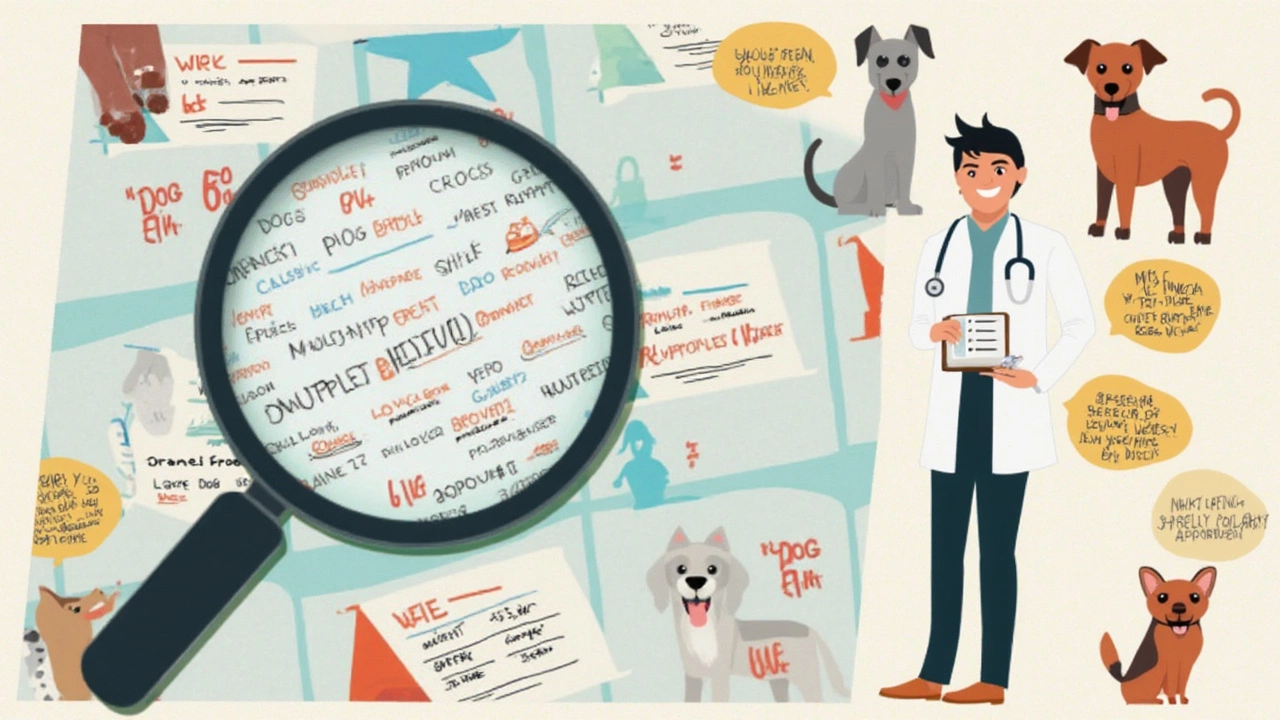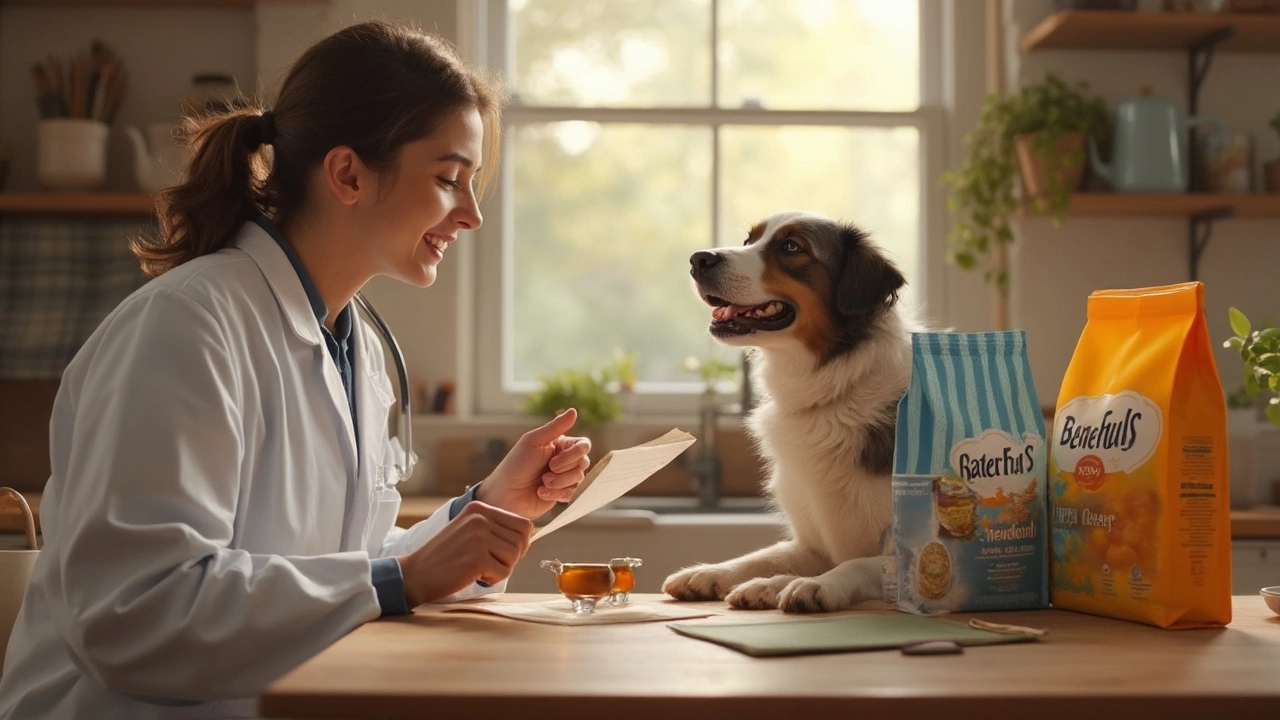If you've ever stood in the dog food aisle staring at bag after bag of kibble, you know the choice can feel overwhelming. Beneful is everywhere, but does a flashy label mean it's good for your dog? That’s the big question: what do vets actually say about Beneful?
Let’s keep it simple and focus on facts. Vets aren’t swayed by marketing—they look at what’s actually in the food. Ingredients like corn, meat by-products, and artificial colorings are front and center in Beneful. Some dogs handle these fine, but others get itchy skin, stomach issues, or just don’t thrive.
I’ve talked to a few vets who’ve seen dogs do perfectly well on Beneful, and others who recommend switching if a pup has allergies or digestive problems. Bottom line: it depends on your dog. Not all dog foods fit all dogs, no matter how common or colorful the bag.
- What's in Beneful? Vets Look at the Ingredients
- Vets Weigh In: Health Concerns, Rumors, and the Facts
- When Beneful Works—And When It Doesn't
- Tips for Choosing the Right Dog Food
What's in Beneful? Vets Look at the Ingredients
Crack open a bag of Beneful and the first thing you’ll notice is its ingredient list. Vets actually pay close attention to what's in dog foods, so let’s break it down.
On most bags of Beneful, the first thing listed is ground yellow corn. Some people think corn is just a cheap filler, but it does give dogs a quick energy source. Still, it doesn’t pack the same punch as whole meats or quality grains. Then there’s chicken by-product meal, real meat (like beef or chicken, depending on the variety), soy flour, and whole wheat flour. And there’s more—artificial colors, preservatives, and even sugar. Yep, sugar in dog food.
Take a look at the main ingredients in a typical Beneful variety:
| Ingredient | Purpose |
|---|---|
| Ground Yellow Corn | Provides carbs and energy |
| Chicken By-Product Meal | Protein from leftover chicken parts |
| Corn Gluten Meal | Binds kibble, adds protein |
| Soy Flour | Protein source |
| Animal Fat (preserved with mixed-tocopherols) | Fat for flavor and energy |
| Meat (chicken or beef) | Real animal protein |
| Sugar | Flavor enhancer |
| Artificial Colors | Makes food look appealing |
So is this what dogs need? Vets point out that real animal proteins should ideally lead the ingredient list, not by-products or corn. The artificial colors and added sugars don’t help nutritionally, but they're still legal and considered safe by pet food standards. Some vets are quick to tell you those extra ‘rainbow’ colors in Beneful are just for owners—your dog won’t care if his food is beige or blue.
It’s not all bad though. Beneful does include vitamins and minerals to round things out and avoid deficiencies. And, you should know, just because a food has by-products doesn’t automatically make it harmful—it’s just not top-shelf stuff. A lot of this comes down to your own standards and your dog’s health needs.
When vets talk about dog food, the Beneful ingredient list is usually called out because it’s heavy on carbs and not as meat-focused as some pricier brands. Still, it meets the minimum nutritional guidelines for dogs, and there’s no proof the ingredients are dangerous for the average, healthy pet.
Vets Weigh In: Health Concerns, Rumors, and the Facts
Search for "Beneful dog food problems" and you'll get a ton of scary stories—everything from weird rashes to lawsuits. It’s easy to get spooked. But what do vets actually see in their clinics? Here’s where things get real.
For starters, most vets agree there’s no clear proof that Beneful causes harm for healthy dogs across the board. The FDA’s been called in multiple times, especially back in 2015 when folks flooded them with concerns. After sample testing, the FDA found no dangerous toxins or contaminants in Beneful. Purina (Beneful’s maker) has weathered lawsuits but none have stuck or forced a product recall.
| Issue | Vet's View | FDA Involvement |
|---|---|---|
| Allergic Reactions | Possible in sensitive dogs, like with any food | Not higher than other brands |
| Serious Illness Outbreaks | No pattern proven | No contamination found |
| Ingredient Quality | Basic, meets AAFCO standards | Tested & cleared |
Lots of rumors swirl around certain ingredients—artificial colors, animal by-products, propylene glycol (yep, that’s in some formulas—it’s safe for dogs in food, but not a fan favorite). Vets say these ingredients aren’t ideal for all pups, but there’s no smoking gun linking Beneful to deadly illnesses in average, healthy dogs.
- If your dog is already healthy and thriving on Beneful, most vets don’t urge an immediate switch.
- If your dog has repeat stomach upsets, skin problems, or itching, it’s worth trying something with fewer colors and fillers—just to see the difference.
- Always talk to your vet before panicking or changing foods, as some symptoms can come from totally unrelated health issues.
So the facts? FDA says Beneful checks out. Vets see occasional sensitivities but no epidemic. The wild stories online—while alarming—don’t match up with broader scientific or vet findings. Still, every dog is different. If your gut says something’s off, listen to it—and your vet.

When Beneful Works—And When It Doesn't
Here’s the deal—Beneful isn’t a one-size-fits-all solution. Some dogs do just fine eating it every day. Dogs with no existing allergies, sensitive stomachs, or medical conditions often eat Beneful with zero drama. You’ll see shiny coats, healthy energy, normal poops, and happy pups. For folks on a budget or with multiple dogs, it can be a simple pick since it’s easy to find at almost any grocery store.
But let’s talk about when Beneful doesn’t work out. Some dogs have issues with common ingredients like corn, wheat, or artificial colors found in this brand. Vets see dogs who develop itchy skin, chronic ear infections, or upset bellies after eating it. And for dogs with grain allergies or special dietary needs—like kidney or liver issues—most vets will point you straight to a prescription or limited-ingredient food instead.
One real-world tip from vets: always watch for changes after switching foods. Red flags include diarrhea, vomiting, excessive scratching, or just a pup who won’t eat. Here’s what smart owners do:
- Keep a log of any new symptoms when you change your dog’s food.
- Feed small test portions first if you’re unsure how your pet will react.
- If something seems off, it’s totally okay to switch back or try a different food.
Some dogs thrive on Beneful, especially if you’re mixing it up with fresh food or keeping mealtime interesting. Other pups need a more specialized (and often pricier) diet to feel their best. The dog food market is huge for a reason—there’s room to find what fits your four-legged friend, even if it takes trying more than one bag.
Tips for Choosing the Right Dog Food
Picking dog food doesn’t have to feel like solving a puzzle. Vets usually say you should look past the packaging and check the label, especially if you’re wondering about brands like Beneful. Here are quick tips that can help you choose what’s best for your dog’s health without overthinking it:
- Check the first five ingredients. These make up most of the food. Look for real meat or meat meals near the top—not just corn or by-products.
- Pick food for your dog’s age and size. Puppy, adult, and senior dogs need different nutrition. Big breeds and small breeds also need different formulas, which is why you see so many choices on store shelves.
- Watch for allergens. If your dog’s always scratching or has messy poops, it might be time to try a food with fewer ingredients. Vets often recommend keeping a food journal when you switch foods.
- Look for AAFCO approval. The Association of American Feed Control Officials (AAFCO) checks if food meets nutrition standards. If you see their stamp, that food covers basic needs for the stage listed (like puppy or adult).
- Skip food with fake colors and lots of fillers. Artificial dyes don’t add anything to your dog’s health and sometimes cause problems for sensitive pups.
Vets sometimes see trends in nutrition issues. Check out this quick table to get a feel for what dogs actually need versus what’s most common in grocery-store dog foods:
| Nutrient | AAFCO Minimum (%) for Adult Dogs | Typical Amount in Major Grocery Brands |
|---|---|---|
| Protein | 18 | 18–26 |
| Fat | 5.5 | 7–15 |
| Fiber | 5 max | 3–8 |
Always remember, a shiny coat and steady energy are better clues to good health than what the commercial on TV says. If your dog seems off, talk to your vet before throwing everything out—sometimes a little tweak in food can do the trick. Don’t fall for every buzzword on the package. Instead, trust labels, your dog's needs, and your vet’s advice.







